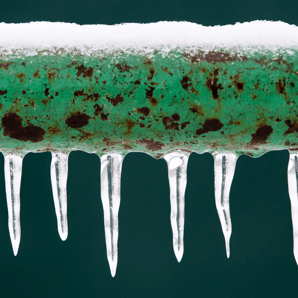As winter's chill sets in, many homeowners find themselves grappling with a common but frustrating problem: frozen pipes. A frozen pipe can disrupt your daily life and potentially lead to costly repairs. However, with a little knowledge and some proactive measures, you can minimize the risk and quickly identify frozen pipes before they become a plumbing catastrophe. In this guide, we'll explore the telltale signs of a frozen pipe, strategies to find the culprit, and tips for preventing this issue in the first place.
How to know if pipes are frozen
- Low or No Water Flow: One of the most obvious indicators of a frozen pipe is low or no water flow from a particular faucet or fixture. If you turn on a tap and only a trickle of water comes out, it's a clear sign that something is amiss.

- Frost on Visible Pipes: Inspect the exposed pipes in your home, particularly in unheated areas like basements, attics, or crawl spaces. If you notice frost or ice on the pipes, this is a strong indication that they are frozen.
- Unusual Odors: A frozen pipe can sometimes be accompanied by a strange odor. This might be due to water and waste not properly flowing through your plumbing system, causing an unpleasant smell.
- Strange Sounds: Frozen pipes can sometimes make unusual sounds. Listen for banging, clanking, or gurgling noises in your plumbing system, as these may suggest that water is trapped and struggling to pass through a frozen section.
Finding the Frozen Pipe
Once you suspect a frozen pipe, it's essential to locate the exact spot of the freeze to address the issue effectively. Here's how you can find the frozen pipe:
- Check Common Trouble Spots: Start by examining pipes in unheated areas, as they are most susceptible to freezing. Follow the cold water supply line from the source and feel for extremely cold sections or visible frost.
- Use a Thermometer: Invest in an infrared thermometer to scan the pipes for temperature differences. A frozen section will be significantly colder than the surrounding areas.
- Inspect Exposed Pipes: Look for exposed pipes in your home and feel them for cold spots or visible frost. You can use your hands or a simple home thermometer to identify temperature variations.
- Turn on Faucets: As you inspect your plumbing, turn on all faucets to check for water flow issues. The faucet that produces little to no water is typically located closest to the frozen section.
- Apply Heat: If you locate a frozen section, use a hairdryer, heating pad, or a space heater to gently warm the pipe. Do not use an open flame, as it can damage the pipe or cause a fire hazard.
Preventing Frozen Pipes
Prevention is always better than dealing with a frozen pipe crisis. Here are some tips to help you safeguard your plumbing during the cold months:
- Insulate Exposed Pipes: Adding insulation to pipes in unheated areas can help prevent them from freezing. This is especially important for outdoor spigots and water supply lines.
- Let Faucets Drip: Allowing a slow drip from faucets during freezing temperatures can help keep water moving through the pipes, reducing the risk of freezing.
- Seal Cracks and Leaks: Seal any gaps or cracks in your home's exterior to prevent cold air from infiltrating and freezing your pipes.
- Keep Your Home Warm: Maintain a consistent temperature in your home, even when you're away. Insulate attics and basements, and consider opening cabinet doors to allow warm air to circulate around pipes.
Frozen pipes can be a major inconvenience, but with a little awareness and preventive measures, you can minimize the risk and quickly identify and address frozen pipes in your home. Keep a watchful eye on the signs, inspect your plumbing system regularly, and don't forget to take steps to prevent freezing in the first place.

.png)